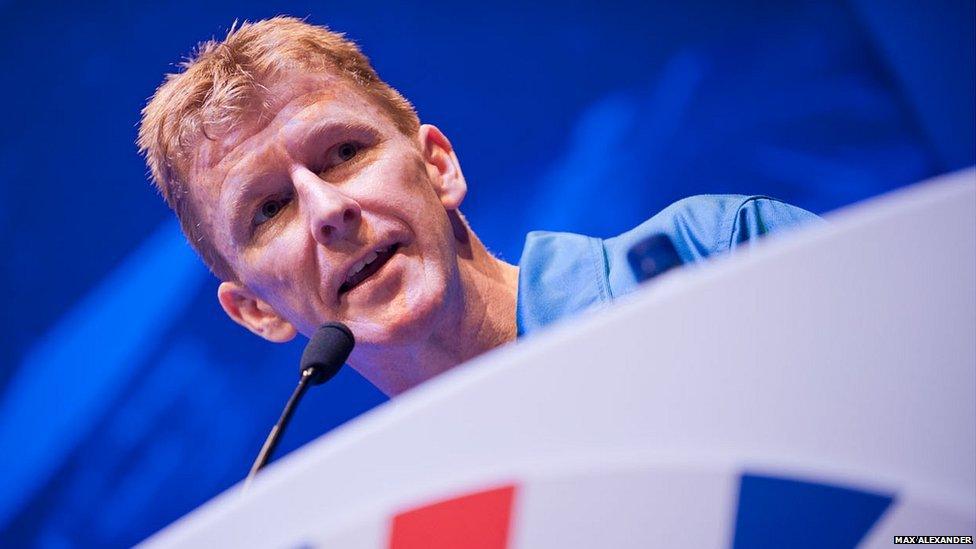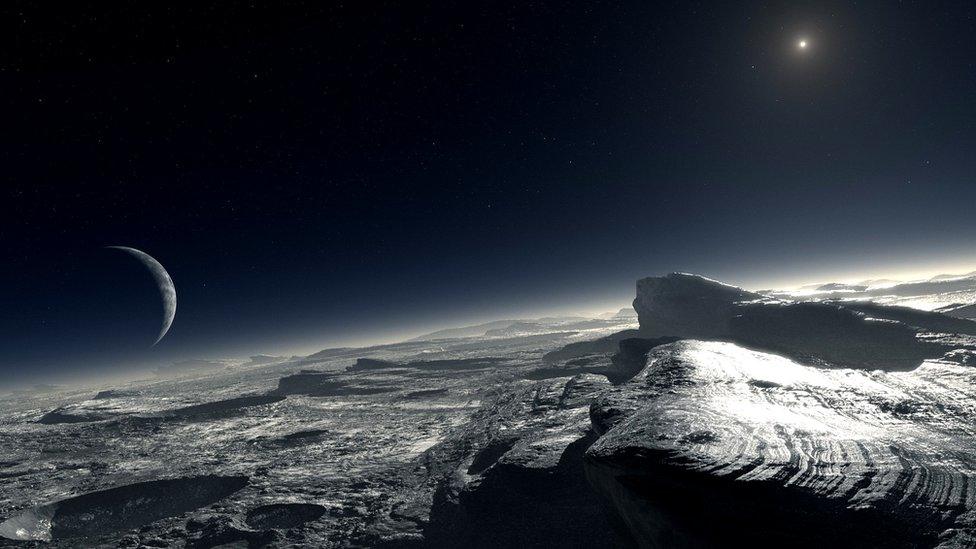What science stories will be big in 2015?
- Published
To help ring in the new year, the BBC's science and environment journalists weigh in on the blockbuster stories heading our way in 2015.
An overview of 2015
David Shukman, science editor
Two very different countdowns will attract a lot of attention next year - one ticking towards to a summit on climate change in Paris, the other towards lift-off for Britain's first astronaut to fly to the ISS.
Usually you can measure international progress on global warming in inches rather than miles. Now, with China and the US, the two biggest emitters, reaching their own accord on cutting greenhouse gases, the UN hopes new impetus could lead, if not to a treaty, then at least to a wider agreement of some kind. To focus the minds of the presidents and prime ministers, a timetable has been set for countries to pledge their own steps to cut carbon ahead of the Paris gathering. Optimists will talk up the prospects. But anyone who witnessed the failure of the last big climate summit - in Copenhagen in 2009 - may sound a little more cynical.
Meanwhile, Tim Peake will be going through his final rounds of training before starting his historic six-month mission into space. In recent decades, manned spaceflight has failed to inspire successive UK governments but ministers are now excited by the chance of generating a massive profile for the growing space industry. Tim's journey begins at Baikonur, Russia's spaceport, where he'll climb into a trusty Soyuz rocket for the six-hour journey to the International Space Station. Blast-off is scheduled for Friday, 20 November. A departure time has already been set: 9pm London time.
1,000mph car
Jonathan Amos, science correspondent

Boom, boom! One of the most anticipated sounds of 2015 will be the double crack of the British Bloodhound car breaking the sound barrier. With a Eurofighter-Typhoon jet engine bolted to a rocket, the vehicle will hope to better the current World Land Speed Record of 763mph (1,230km/h) set by Andy Green in Thrust SSC in 1997.
The RAF Wing Commander will again be at the controls when Bloodhound SSC runs across a dried-up lakebed in Northern Cape, South Africa, towards the end of the year. The goal ultimately is to push the record beyond 1,000mph (1,610km/h), but that will have to wait until 2016. It has been quite a struggle just getting to the start line.
Finding the technical solutions to keep the car from going airborne during its high-speed runs has been the main reason why the project is now four years beyond the original schedule; and the required finances have more than tripled as a consequence. But the team believes it is now ready to make its mark.
Back in 1997, Thrust SSC was one of the very first stories to be reported by the then fledgling BBC News website. Our online service had started up just weeks earlier. We had some initial text copy, followed by still imagery, before finally video filtered out from the BBC team that had witnessed the event. How times have changed. Bloodhound SSC will be festooned with cameras and sensors, as will the 11-mile-long (18km) racetrack that has been specially prepared for it on Hakskeen Pan. All of this information will be streamed instantly to a global internet audience. Expect this to be one of the standout engineering moments of 2015.
Brits in space
By Paul Rincon, section editor, website

There were eyebrows raised in Europe when Chichester-born Army Major Tim Peake was selected as an Esa astronaut back in 2009. UK governments have traditionally scorned human spaceflight and have contributed minimal amounts to this specific European Space Agency programme. But "Major Tim" was a standout candidate and some within the space agency hoped the move might encourage greater participation from Britain.
Thus, in late 2015, Tim will carry the Union flag on his arm as he launches in a Russian spacecraft to begin a six-month residence on the International Space Station (ISS).
Observers will be watching to see if the "Tim effect" can inspire a new generation of young scientists and engineers, boosting confidence in Britain's hi-tech industries. To that end, space agency chiefs have already organised competitions for schoolchildren to concoct a space meal for Tim and to design his mission patch.
Following his rigorous programme of astronaut training, the former helicopter pilot should begin his mission in November 2015. And he seems equally comfortable in his ambassadorial role as he does in an underwater training tank, having dealt adeptly with a grilling by Jeremy Paxman on Newsnight in 2013.
The road to Paris
Roger Harrabin, environment analyst

This is the year when politicians are supposed to design and manufacture a new universal treaty on climate change.
There will inevitably be a gulf between the UN summit talks in Paris in December and what scientists say is needed. But the pressure is on.
The first milestone on the Paris road comes in March when the US, China and the EU should pledge their actions to reduce the world's reliance on fossil fuels.
By November, all nations - rich and poor - will be asked to volunteer to stabilise or cut emissions, although the deal will rely on peer pressure and will not be legally binding.
If rich nations do not produce enough cash to help the poor get clean energy, the summit will surely fail. And poor nations won't sign a deal which allows the rich to dodge responsibility for cutting emissions.
But climate will be firmly on the G7 and G20 agendas. And none of the great powers wants to suffer the political impotence that shamed the 2009 climate summit in Copenhagen.
Ground beneath our feet
Mark Kinver, environment reporter

Undoubtedly, anticipation will build as negotiations continue throughout the year ahead of the key UN climate summit in Paris.
But the coming 12 months is just as important, if not more so, for what is beneath our feet.
2015 is the UN International Year of Soils, external, which hopes to highlight the importance of one of the most complex biological materials on the planet.
A handful of the stuff can contain billions of microorganisms, and it takes more than 1,000 years to form just a centimetre of topsoil.
We abuse it or ignore it at our peril. Without soil, we do not eat and lose vital ecosystem services that underpin our economic, social and environmental wellbeing.
At the same time as the world's climate negotiators will be sweating in Paris, the world's soil scientists will be gathering in another part of France, in Dijon, for the first Global Soil Biodiversity Conference, external ahead of the publication of the first Status of World Soil Resources Report, external.
Soil is the largest terrestrial carbon store - absorbing more than 10% of the world's emissions - so no matter how much politicians in Paris pontificate or pledge, without healthy soil (and there are more than 100,000 types in the world) their efforts are likely to turn to dust.
Mighty dwarfs
Paul Rincon, section editor, website

You wait ages for a mission to a dwarf planet and then two come along at once.
In July, a Nasa spacecraft will make a close pass of Pluto - the enigmatic frozen world that lies an average of 5.9 billion kilometres from the Sun. Discovered in 1930 by Clyde Tombaugh, Pluto held planetary status until 2006, when an astronomical body demoted it to "dwarf planet" - a category of similarly petite objects scattered throughout our Solar System.
But Pluto's relegation to a lower league won't kill off any of the excitement about this unique mission, which will also gather data on the object's companion moons.
All we know of Pluto's surface comes from some relatively blurry images captured by the Hubble Space Telescope, but this will be the first time any spacecraft has been up-close-and-personal with the object formerly known as "the ninth planet".
Earlier in 2015, in March to be exact, Nasa's Dawn spacecraft will turn up at another mysterious world called Ceres, which is the largest object in the asteroid belt - the collection of rocks that lies between Mars and Jupiter. Unlike the other irregular-looking objects in this belt, Ceres is so big it has taken on a near-spherical shape.
Density measurements suggest there could be ample stores of water-ice on Ceres. Scientists think that when the object swings through the part of its orbit that is closest to the Sun, a portion of its icy surface becomes warm enough to cause water vapour to gush out in plumes. The Dawn team will soon be able to test this theory.
Both missions - to Pluto and Ceres - will be key events in the science calendar for 2015.
Smashing return
By Jonathan Webb, website science reporter

In 2015 the Large Hadron Collider (LHC), the world's most famous circular subterranean tunnel, will again fire up its accelerators after a two-year hiatus.
The team at Cern, the European particle physics centre near Geneva, Switzerland, has spent the break upgrading the collider.
Its next three-year run of experiments will fire beams of particles around its 27km (17-mile) circumference with almost twice as much energy as before.
After successfully confirming the existence of the Higgs boson in 2012, teams running Cern's four main experiments still have "unfinished business with the Universe", according to Prof Tara Shears from the University of Liverpool.
As well as more fully understanding the Higgs's properties, there are hopes of answering some big, outstanding questions relating to dark matter, antimatter and supersymmetry.
Prof Shears leads a team working on LHCb, external, an experiment buried on the French side of the border that aims to figure out why the Universe is mostly matter, when the Big Bang should have produced an equal amount of antimatter.
"We want to see what the new data shows us about antimatter, and why there's so little in the Universe," she said.
"We want to chase the hints we've seen in previous measurements, whose behaviour didn't quite match our expectations, in case these hints turn into discoveries."